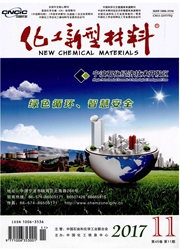

 中文摘要:
中文摘要:
高温自生压力法(RAPET)是一种新型、简单而又高效的无机材料制备方法。以含水天然产物如甘薯、香菜和野藤等为前驱物,经冷冻干燥其骨架结构得以维持,然后通过RAPET法在700℃碳化,制得了保持天然物原有微观骨架结构的碳材料;以液态油脂花生油为原料,经RAPET法直接制得微米碳球;粘胶纤维和脱脂棉经RAPET碳化后能维持其原有纤维形貌;用钛酸丁酯(TBOT)和正硅酸四乙酯(TEOS)浸渍的脱脂棉和粘胶纤维,经RAPET法一步合成了C/TiO2和C/SiO2复合材料。利用扫描电子显微镜(SEM)观察了产物的形貌,以比表面积及孔径分布测试仪对产物的比表面积和孔结构进行了表征,通过X射线衍射(XRD)研究了所得C/TiO2和C/SiO2复合材料的晶相特征。结果显示,所得产物比表面积从42/g到405m2/g不等,C/TiO2中TiO2晶相为锐钛矿型。
 英文摘要:
英文摘要:
The reaction under autogenic pressure at elevated temperature (RAPET) is a new simple efficient method to prepare inorganic materials. The carbon and carbon composites were prepared via the method of RAPET using natural products such as sweet potato and coriander and the absorbent cotton and viscose fiber doped by TBOT and TEOS. The carbon and the carbon composites were studied with scanning electron microscopy (SEM), X-ray diffraction (XRD) and nitrogen adsorption-desorption measurements. The BET surface area of the materials were different from 4m2/g to 405m2/g. The XRD investigation indicated that the phases of the TiO2 in the carbon/TiO2 composites were anatase.
 同期刊论文项目
同期刊论文项目
 同项目期刊论文
同项目期刊论文
 Template Synthesis of Mesoporous Carbon Microfibers as a Catalyst Support for Methanol Electrooxidat
Template Synthesis of Mesoporous Carbon Microfibers as a Catalyst Support for Methanol Electrooxidat Theoretical studies of stereoselectivities in the direct organocatalytic Mannich reactions involving
Theoretical studies of stereoselectivities in the direct organocatalytic Mannich reactions involving Theoretical studies of stereoselectivities in the direct anti-Mannich and syn-aldol reactions cataly
Theoretical studies of stereoselectivities in the direct anti-Mannich and syn-aldol reactions cataly Vapor-phase silanization of oxidized porous silicon for stabilizing composition and photoluminescenc
Vapor-phase silanization of oxidized porous silicon for stabilizing composition and photoluminescenc Theoretical studies of stereoselectivities in the direct syn- and anti-Mannich reactions catalyzed b
Theoretical studies of stereoselectivities in the direct syn- and anti-Mannich reactions catalyzed b Hydrothermal synthesis and characterization of hexagonal gamma-MnS single crystal nanorods in presen
Hydrothermal synthesis and characterization of hexagonal gamma-MnS single crystal nanorods in presen Origins of opposite syn-anti diastereoselectivities in primary and secondary amino acid-catalyzed in
Origins of opposite syn-anti diastereoselectivities in primary and secondary amino acid-catalyzed in Synthesis of Self-Organized Polycrystalline F-doped TiO2 Hollow Microspheres and Their Photocatalyti
Synthesis of Self-Organized Polycrystalline F-doped TiO2 Hollow Microspheres and Their Photocatalyti Density Functional Theoretical Study of PKa of RCOOH(R=H, CH3, and C2H5) Using the Combination of th
Density Functional Theoretical Study of PKa of RCOOH(R=H, CH3, and C2H5) Using the Combination of th Preparation of PS@SiO2, PS@TiO2,PS@TiO2/SiO2 core-shell composites by a spray drying process and the
Preparation of PS@SiO2, PS@TiO2,PS@TiO2/SiO2 core-shell composites by a spray drying process and the 期刊信息
期刊信息
